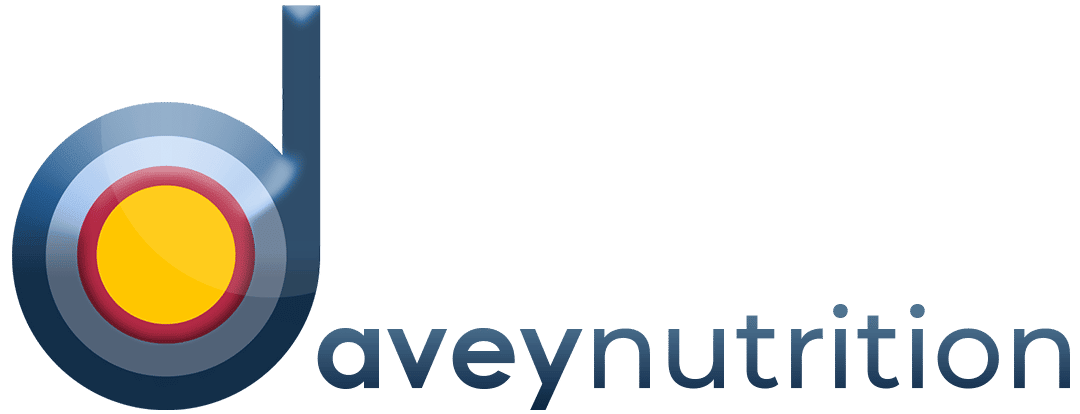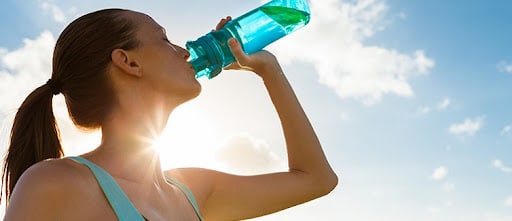Nutrition For Youth Athletes
Part 1
- The key nutritional considerations for youth athletes
- Macronutrients function and role in the body
- The importance of fruit and vegetables for a balanced diet
- The role of calcium and vitamin D for bone health
- Meal frequency and timing
- Hydration
- Supplementation
The Fundamentals of Nutrition
Proper nutrition is vital for child and adolescent athletes to attain proper growth and perform optimally in sports. Sports nutrition enhances athletic performance by decreasing fatigue and the risk of disease and injury; it also enables athletes to optimize training and recover faster. Between the ages of 13-18 years, it is a time of growth spurts, bone and brain development, and pubertal changes. It is therefore essential young athletes are fuelling their bodies with enough energy for these changes to occur properly.
We get our energy through the foods/ fluids we eat and drink every day. Without getting out of bed in the morning, our bodies need the energy to keep our essential organs such as our heart, brain and lungs functioning correctly. Therefore, to support the extra energy demands for exercise and performance, and to support growth and development, young athletes need to make sure they are eating enough to maximise performance and support recovery. If a young athlete is not eating enough to support the demands of their exercise, it can lead to tiredness, delayed recovery, poor sleep, hormonal fluctuations, poor athletic performance, and poor concentration in school.

The Performance Nutrition Pyramid
Below is the performance nutrition pyramid. Athletes should think of their nutrition in terms of setting a strong foundation and progressing to the top end. Click here for a summary of the priorities/ key elements of nutrition.
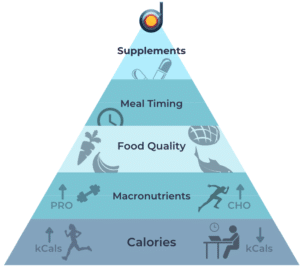
-
Calories/ Energy
Calories are the energy we get from food. When it comes to sports nutrition the most important thing is your total calorie/ energy intake. This can be seen at the bottom of the pyramid. This means that first, young athletes need to make sure they are eating enough total calories to support their performance and their essential bodily functions. Prolonged underfuelling puts athletes at risk of developing low energy availability (LEA). This has been a growing concern with increased prevalence in both elite and non-elite sports, especially female athletes. Learn more: Low energy availability
Sign you are underfuelling:
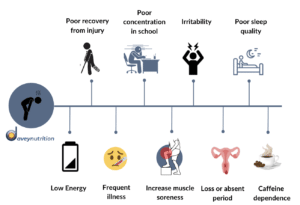
-
Nutrients
Nutrients are substances that are found in foods that give us energy and allow our bodies to perform their essential functions. There are two types of nutrients: Macronutrients & Micronutrients.
Macronutrients:
Macronutrients are the nutrients we need in large amounts.
There are three types: Protein, carbohydrates and fat. Most of your energy intake will come from macronutrients and they provide the fuel for physical activity and sports participation

Click here for the recipe above.
Carbohydrates
What are examples of carbohydrate food?
Pasta, rice, noodle, potatoes, oats, whole grains, breakfast cereal, bread, quinoa, and fruit.
There are two types of carbohydrates:
- Simple carbs: They are broken down by the body more rapidly and provide a quick source of energy. For example: pancakes, honey, dried fruit, fruit juices, and jelly babies.
- Complex carbs: They are broken down a little bit slower and provide the body with a steady source of energy. For example: brown pasta, rice, whole grains, oats, and potatoes.
The energy from carbohydrate foods powers an athlete’s body and brain. No matter what your sport is, carbohydrates are essential for the best performance as they can limit fatigue and maintain energy levels. When taking part in high-intensity exercise eg: Gaelic football, soccer, rugby, sprinting etc., it is carbohydrates that fuel your performance as they are broken down by the body quickly and can be utilised as fuel. When carbohydrate intake is too low, energy levels, stamina, strength and decision making can suffer during exercise. This can lead to poor performance and increased injury risk.
Carbohydrates are not only important for energy, but they are also really important for a well-balanced diet. They provide dietary fibre which can help maintain a healthy gut, and prevent constipation and other digestion problems.

Download your free carbohydrate resource here!
Protein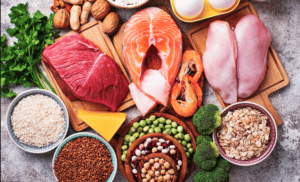
What foods contain protein?
Animal sources: Chicken, turkey, red meat, fish, eggs, dairy products (milk, cheese, yogurt).
Plant sources: Nuts, quinoa, tofu, beans, legumes, Quorn.
Protein plays a big role in keeping the body functioning properly, and a healthy nourished body is one that can perform at the highest level. For growing athletes, protein is a critical nutrient for growth and development, helping build muscle and create new tissue. It is often referred to as a ‘building block’ as it makes up muscle tissue, hormones, enzymes and plays a role in proper immune function.
For athletes, protein plays an added role in muscle repair. Naturally, when we exercise, muscle tissue is broken down, this can be from repeated sprinting and jumping movements. During periods of rest, this muscle tissue is rebuilt. Because young athletes are growing, building, breaking down and repairing muscle, protein is an essential nutrient that should be incorporated into their diet every day.

Should I distribute my protein intake throughout the day or is it OK to have it in 1-2 meals?
Protein is most effectively used in the body when it spread throughout the day, rather than in 1 or 2 large meals. This will support recovery from training, maintain lean mass and keep energy levels stable. Aim to give your body 4-5 protein feedings throughout the day.
For example:
Breakfast – Lunch – Dinner – Snack

Scrambled Egg & Toast – Chicken Ciabatta – Meatballs & Chips – Smoothie Bowl
Learn more: Protein- Your questions answered
Download your free protein resource here!
Fat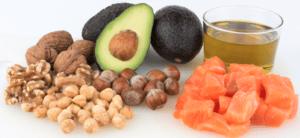
Fats are essential for athletes striving for a quality performance diet. Fats play an important role in heart health, brain function, hormone production, immune function, and vitamin and mineral absorption, and they also provide a source of energy for low-intensity exercise. Athletes should focus on consuming moderate amounts of unsaturated fats- found in foods like olive and rapeseed oil, nuts, seeds and avocados. While limiting saturated fats- found in foods such as margarine, fast foods, baked pastries/ pies and biscuits.
What can happen if you have too little/much fat?
- Too little fats may contribute to low energy levels, poor immune function, and inconsistent menstrual cycles in females.
- Too much fat can contribute to weight gain and health issues such as heart disease.
3. Food quality/ Micronutrients
Food quality refers to the nutritional content of food. We have already mentioned good sources of our macronutrients: carbohydrates, protein and fat.
But what about our micronutrients?
Fruit and vegetables are packed full of micronutrients and provide our body with essential vitamins, minerals and antioxidants which are essential for our bodies to function optimally.
Strive For 5
Eat at least five portions of fruit and vegetables a day. Fruit and vegetables are a very important part of a healthy balanced diet. They are great sources of fibre, contain essential vitamins and minerals such as Vit A, C, K, support normal immune function, and have antioxidant properties that can help with wound healing and play a role in recovery from injury. Remember variety is key. Aim to include a wide range of colours of fruit and veg daily. They can be fresh, frozen and canned, they all count!
Tip: Try a new fruit and vegetable each week. When preparing a meal try to add 2-3 different types of fruit or veg. Aim for as much colour as possible. Eat the rainbow!

Example: Add;
- Berries to your porridge
- Banana to your Weetabix.
- Spinach to your scrambled eggs
- Salad to your sandwich
- Mixed fruit to your yoghurt
- Mixed veg to your bolognaise
Other important nutrients for young athletes include:
Calcium and Vitamin D
Calcium and Vitamin D contribute to strong bones in young athletes. Childhood and adolescence are the prime bone-building years as peak bone mass is typically achieved at 25 years old. Therefore, young athletes want to ensure they are building strong healthy bones from a young age.
Many young people, especially those who are dairy avoidant, have a diet that is lacking in needed calcium. The body needs calcium for critical body functions. When dietary intake is poor, the body will “steal” calcium from the bone, thus further contributing to poor bone density over time.
Aim for 3 servings of calcium per day.
Examples: Milk, cheese, yoghurt, bok choy, calcium-fortified soy products and breakfast cereals.
Here are some meal ideas to help you meet your goal!
Tuna Pasta Bake Overnight Berry Surprise Crispy Tofu Pasta
Vitamin D plays a role in helping absorb calcium in the body. The body creates vitamin D from direct sunlight on the skin. It can be found in small amounts in foods such as oily fish, red meat, eggs and fortified foods (E.g cereal). In Ireland and the UK, it is difficult to get adequate Vitamin D due to the lack of sunlight, therefore, it is advised during the Autumn and Winter months to take a supplement of 10mg per day.
-
Meal Frequency and timing:
Meal timing is the term given to the manipulation of the structure or timing of any meals or nutrients across the day to provide a benefit for performance, recovery and/or adaptation.

For athletes, when you eat pre and post-exercise is critical for performance. For pre-exercise meals, the guide is not to eat a large meal within two to three hours before your exercise.
Post-exercise, eat within an hour of completing your session for the best recovery. Establishing meal frequency and timing that suits you and your lifestyle will be really important in allowing you to perform at your best. Pre/ post-exercise nutrition will be covered in more detail in Part 2 and part 3 of this series. For more information on meal timing, check our blog: Meal timing
-
Supplements

Sports nutrition supplements are not recommended for athletes under the age of 18. In young athletes, nutritional needs are best met by a balanced diet, rather than supplements. Athletes should focus instead on following the basics of proper hydration and nutrition. Both are crucial in supporting growth and athletic performance.
From a health point of view, a vitamin D supplement of 10mg per day is recommended between the months of Autumn and Winter. If you have any concerns about nutritional deficiencies due to avoidance of specific foods due to allergies or intolerances, speak to your GP or registered Dietitian or Nutritionist.
Summary:
- Meeting your appropriate level of energy is critical to be able to complete daily tasks and support your sports performance.
- Carbohydrates provide fuel during high-intensity exercise and are important for gut health and digestion.
- Protein is essential for building and repairing muscle tissue.
- Fats are essential for athletes striving for a quality performance diet. Focus on consuming a moderate amount of unsaturated fats in your diet.
- Aim to consume a wide variety of fruits and vegetables each day.
- Aim for 3 portions of calcium daily to support bone development.
- Sports supplementation is not recommended under the age of 18.
References:
Egan, B. (2016) “Protein intake for athletes and active adults: Current concepts and controversies,” Nutrition Bulletin, 41(3), pp. 202–213. doi:10.1111/NBU.12215.
Kerksick, C.M. et al. (2018) “ISSN exercise & sports nutrition review update: research & recommendations,” Journal of the International Society of Sports Nutrition 2018 15:1, 15(1), pp. 1–57. doi:10.1186/S12970-018-0242-Y.
Mata, F. et al. (2019) “Carbohydrate Availability and Physical Performance: Physiological Overview and Practical Recommendations,” Nutrients, 11(5). doi:10.3390/NU11051084.
Nair, R. and Maseeh, A. (2012) “Vitamin D: The ‘sunshine’ vitamin,” Journal of Pharmacology & Pharmacotherapeutics, 3(2), p. 118. doi:10.4103/0976-500X.95506.
Slavin, J.L. and Lloyd, B. (2012) “Health Benefits of Fruits and Vegetables,” Advances in Nutrition, 3(4), p. 506. doi:10.3945/AN.112.002154.
Stellingwerff, T. et al. (2021) “Overtraining Syndrome (OTS) and Relative Energy Deficiency in Sport (RED-S): Shared Pathways, Symptoms and Complexities,” Sports medicine (Auckland, N.Z.), 51(11), pp. 2251–2280. doi:10.1007/S40279-021-01491-0.
